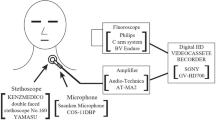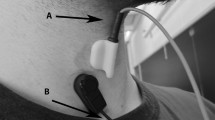Abstract
Cervical auscultation is a noninvasive technique for the exploration of swallowing and has been used since the 1960s. The aim of our study was to describe how the volume and consistency of the bolus affect swallowing acoustic sound characteristics in healthy subjects. Twenty-three subjects aged from 20 to 59 years were included (13 women and 10 men). A microphone mounted on a stethoscope chest piece, positioned on the skin on the right side in front of the posteroinferior border of the cricoid cartilage, was used; it was connected to a computer for acoustic recordings. Each subject swallowed 2-, 5-, and 10-ml aliquots of water, yogurt, and mashed potato. Each bolus was administered once, with a period of at least 30 s between each swallow. For each recorded sound, the total duration of the sound and the duration of each sound component (SC) (SC1, SC2, and SC3) and interval (IT1 and IT2) between the SCs were measured. For all records, the average duration of acoustic measures was calculated. Differences according to the volume and the consistency of the swallowed bolus were assessed using Student’s t test for paired data. We calculated the percentage of recordings that included each SC. We also compared results between men and women using Student’s t test. We successfully interpreted 540 of the 621 (87 %) records. The results indicated that the average total duration of the sound, and especially the average duration of SC2, increased with increasing volume and was greater for mashed potato than for the boluses of other consistencies. SC2 was present in all of the records.



Similar content being viewed by others
References
Jean A. Brain stem control of swallowing: neuronal network and cellular mechanisms. Physiol Rev. 2001;81:929–69.
Cook IJ, Dodds WJ, Dantas RO, Massey B, Kern MK, Lang IM, Brasseur JG, Hogan WJ. Opening mechanisms of the human upper esophageal sphincter. Am J Physiol. 1989;257:748–59.
Langmore SE, Schatz K, Olsen N. Fiberoptic endoscopic examination of swallowing safety. Dysphagia. 1988;2:216–9.
Miller LS, Dai Q, Sweitzer BA, Thangada V, Kim JK, Thomas B, Parkman H, Soliman AM. Evaluation of the upper esophageal sphincter (UES) using simultaneous high-resolution endoluminal sonography (HRES) and manometry. Dig Dis Sci. 2004;49:703–9.
Mielens JD, Hoffman MR, Ciucci MR, Jiang JJ, McCulloch TM. Automated analysis of pharyngeal pressure data obtained with high resolution manometry. Dysphagia. 2011;26:3–12.
Ertekin C, Aydogdu I. Electromyography of human cricopharyngeal muscle of the upper esophageal sphincter. Muscle Nerve. 2002;26:729–39.
Albiter M, Petrow P, Kolb F, Bretagne E, Luboinski B. Sigal R [Swallowing study with kinetic MRI using a single shot fast spin echo sequence in healthy volunteers and patients treated for head and neck cancer]. J Radiol. 2003;84:311–6 [in French].
Lear CS, Flanagan JB, Mooress CF. The frequency of deglutition in man. Arch Oral Biol. 1965;10:83–99.
Mackoviak RD, Brenman HS, Friedman MH. Acoustic profile of deglutition. Proc Soc Exp Biol Med. 1967;123:1149–52.
Hamlet JA, Nelson RJ, Patterson RL. Interpreting the sound of swallowing: fluid flow through the cricopharygeus. Ann Otol Rhinol Laryngol. 1990;99:749–52.
Boiron M, Rouleau P, Metman EH. Exploration of pharyngeal swallowing by audiosignal recording. Dysphagia. 1997;12:86–92.
Morinière S, Beutter P, Boiron M. Sound component duration of healthy human pharyngoesophageal swallowing: a gender comparison study. Dysphagia. 2006;21:175–82.
Morinière S, Boiron M, Alison D, Makris P, Beutter P. Origin of the sound components during pharyngeal swallowing in normal subjects. Dysphagia. 2008;23:267–73.
Morinière S, Boiron M, Brunereau L, Beutter P, Patat F. Pharyngeal swallowing sound profile assessed after partial and total laryngectomy. Dysphagia. 2011;26:366–73.
Kahrilas PJ, Lin S, Chen J, Logemann JA. Oropharyngeal accommodation to swallow volume. Gastroenterology. 1996;111:297–306.
Ghosh SK, Pandolfino JE, Zhang Q, Jarosz A, Kahrilas PJ. Deglutive upper esophageal sphincter relaxation: a study of 75 volunteer subjects using solid-state high-resolution manometry. Am J Physiol Gastrointest Liver Physiol. 2006;291:525–31.
Doods WJ, Stewart ET, Logemann JA. Physiology and radiology of the normal oral and pharyngeal phases of swallowing. AJR Am J Roentgenol. 1990;154:953–63.
Eyigor S, Perlman A, He X. Effects of age, gender, bolus volume and viscosity on acoustic signals of normal swallowing. Turk J Phys Med Rehabil. 2007;53:94–9.
Takahashi K, Groher ME, MichiI K. Methodology for detecting swallowing sounds. Dysphagia. 1994;9:54–62.
Boiron M, Benchellal Z, Huten N. Study of swallowing sound at the esophagogastric junction before and after fundoplication. J Gastrointest Surg. 2009;13:1570–6.
Youmans SR, Stierwalt JA. Normal swallowing acoustics across age, gender, bolus viscosity and bolus volume. Dysphagia. 2011;26:374–84.
Takahashi K, Groher ME, Michi K. Symmetry and reproducibility of swallowing sounds. Dysphagia. 1994;9:168–73.
Cichero JA, Murdoch BE. Acoustic signature of the normal swallow: characterization by age, gender, and bolus volume. Ann Otol Rhinol Laryngol. 2002;111:623–32.
Perlman AL, Ettema SL, Barkmeier J. Respiratory and acoustic signal associated with bolus passage during swallowing. Dysphagia. 2000;15:89–94.
Lebel D, Parel C, Thouvenot J. Exploration de la déglutition à partir de son signal sonore. Arch Int Physiol Biochim. 1990;98:75–86.
Conflict of interest
All of the authors have no conflicts of interest to disclose.
Author information
Authors and Affiliations
Corresponding author
Rights and permissions
About this article
Cite this article
Hammoudi, K., Boiron, M., Hernandez, N. et al. Acoustic Study of Pharyngeal Swallowing as a Function of the Volume and Consistency of the Bolus. Dysphagia 29, 468–474 (2014). https://doi.org/10.1007/s00455-014-9529-6
Received:
Accepted:
Published:
Issue Date:
DOI: https://doi.org/10.1007/s00455-014-9529-6




